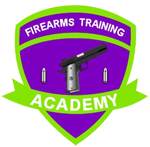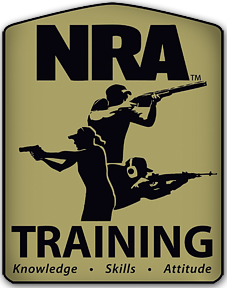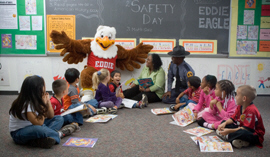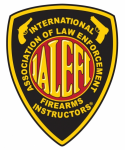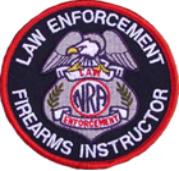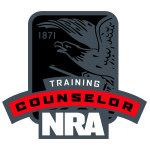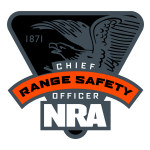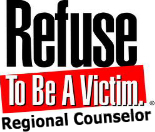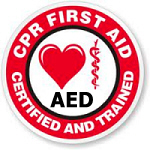Firearms Training - Course Catalog
Personal Firearms Instruction
So you want to learn how to shoot or just get some valuable pointers on how to improve your stance, grip, offhand shooting, accuracy etc and you want to do it privately. I can help, all you have to do is contact me and let me know what you want to learn or improve on such as pistol, rifle, shotgun, defensive pistol, concealed carry and more. Please, if you buy a gun, take the steps to know how to operate it safely. It could save your life or the life of a loved one.
NRA Basic Pistol Course
This course is at least 8-hours long and includes classroom and range time learning to shoot revolvers and semi-automatic pistols. Students learn NRA’s rules for safe gun handling; pistol parts and operation; ammunition; shooting fundamentals; range rules; shooting from the bench rest position, and two handed standing positions; cleaning the pistol; and continued opportunities for skill development. Students will receive the NRA Guide to the Basics of Pistol Shooting handbook, NRA Gun Safety Rules brochure, Winchester/NRA Marksmanship Qualification booklet, take a Basics of Pistol Shooting Student Examination, and course completion certificate.
NRA Personal Protection In The Home Course
This is an eight-hour course. Students should expect to shoot approximately 100 rounds of ammunition. Students will learn basic defensive shooting skills, strategies for home safety and responding to a violent confrontation, firearms and the law, how to choose a handgun for self-defense, and continued opportunities for skill development. Students will receive the NRA Guide to the Basics of Personal Protection In The Home handbook, NRA Gun Safety Rules brochure, the Winchester/NRA Marksmanship Qualification booklet, and course completion certificate.
NRA Basic Personal Protection In The Home course is for law-abiding adult citizens, as defined by applicable federal, state, or local law, and experienced shooters (shooters able to show mastery of the basic skills of safe gun handling, shooting a group, zeroing the firearm, and cleaning the firearm) to maximize what can be learned from this course. Proof of shooting experience can be one of the following: NRA Basic Pistol Course Certificate, NRA FIRST Steps Course Certificate, NRA pistol competitive shooting qualification card, military DD 214 with pistol qualification, or passing the Pre-Course Assessment.
NRA Personal Protection Outside The Home Course
The course teaches students the knowledge, skills and attitude essential for avoiding dangerous confrontations and for the safe, effective and responsible use of a concealed pistol for self-defense outside the home. Students have the opportunity to attend this course using a quality strong side hip holster that covers the trigger, or a holster purse. From a review of safe firearms handling and proper mindset to presentation from concealment and multiple shooting positions, this course contains the essential skills and techniques needed to prevail in a life-threatening situation. 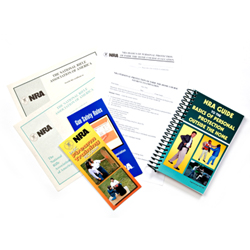 The NRA Personal Protection Outside the Home is divided into two levels (basic and advanced). Level one is a nine-hour course and offers the essential knowledge and skills that must be mastered in order to carry, store, and use a firearm safely and effectively for personal protection outside the home. Upon completion of level one, students may choose to attend level two, which is an additional five hours of range training and teaches advanced shooting skills.
The NRA Personal Protection Outside the Home is divided into two levels (basic and advanced). Level one is a nine-hour course and offers the essential knowledge and skills that must be mastered in order to carry, store, and use a firearm safely and effectively for personal protection outside the home. Upon completion of level one, students may choose to attend level two, which is an additional five hours of range training and teaches advanced shooting skills.
After the classroom portion, students should expect to spend several hours on the range and shoot approximately 100 rounds of ammunition during level one. Level two involves five additional hours on the range and approximately 115 rounds of ammunition. The ammunition requirements are minimum and may be exceeded. Students will receive the NRA Guide to the Basics of Personal Protection Outside The Home handbook, NRA Gun Safety Rules brochure and the appropriate course completion certificates(s), NRA Basic Personal Protection Outside The Home (identifies strong-side hip holster or purse use) certificate, and NRA Advanced Personal Protection Outside The Home certificate.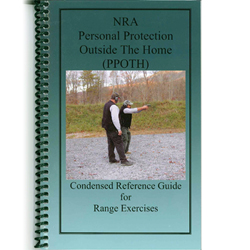 The NRA Basics of Personal Protection Outside The Home is for adult individuals who are not disqualified from possessing a firearm as defined by applicable federal, state, or local law and are of good repute and possess defensive pistol skills presented in the NRA Basics of Personal Protection In The Home Course. Participants must also understand the basic legal concepts relating to the use of firearms in self-defense, and must know and observe not only general gun safety rules, but also those safety principles that are specific to defensive situations. Prospective participants can demonstrate that they have the requisite knowledge, skills, and attitudes by producing an NRA Basic Personal Protection In The Home Course Certificate, or by passing the pre-course evaluation.
The NRA Basics of Personal Protection Outside The Home is for adult individuals who are not disqualified from possessing a firearm as defined by applicable federal, state, or local law and are of good repute and possess defensive pistol skills presented in the NRA Basics of Personal Protection In The Home Course. Participants must also understand the basic legal concepts relating to the use of firearms in self-defense, and must know and observe not only general gun safety rules, but also those safety principles that are specific to defensive situations. Prospective participants can demonstrate that they have the requisite knowledge, skills, and attitudes by producing an NRA Basic Personal Protection In The Home Course Certificate, or by passing the pre-course evaluation.
Note: Lesson III of the Personal Protection In and Outside the Home courses "Firearms and the Law", and Legal Aspects of Self-Defense is conducted by an attorney licensed to practice law within the state in which this course is given and who is familiar with this area of the law, or a Law Enforcement Officer (LEO) who possesses an intermediate or higher Peace Officer Standards and Training (POST) certificate granted within the state, or an individual currently certified to instruct in this area of the law by the state in which this course is presented.
NRA Defensive Pistol
The NRA Defensive Pistol Course will focus on the techniques needed to develop a defensive mindset. The goal of the course will be to develop the knowledge, skills, and attitude necessary to carry and use a concealed pistol ethically, responsibly, and with confidence. As a result of participating in this course, the student will be able to explain and demonstrate the following: How to apply the NRA Rules for Safe Gun Handling when carrying a concealed firearm, basic principles of concealment, the difference between cover and concealment, drawing from the holster, levels of mental awareness, developing the proper mindset when using a pistol for personal protection, clearing common stoppages, and more.
Course Length: Approximately 5 hours
The following topics will be reviewed in the course:
- The importance of carrying and using a pistol responsibly and ethically for personal protection
- How the NRA Rules for Safe Gun Handling are applied to concealed carry
- Basic principles of concealment
- Presenting a pistol - reholster
- Mental awareness
- Mental preparation to develop a defensive mindset for carrying and using a pistol for personal
protection
- Techniques for avoiding life-threatening confrontations
- Explain the psychological and physiological changes that may occur during an attack
- Flash sight picture
- Reloading under stress
- Clear common stoppages
- Cover and concealment
- Presenting a pistol from concealment and shoot targets at varying distances
- .....and more
Participant equipment requirements:
- Pistol- minimum calibers, .38 Special or 9mm.
- Three magazines or speed loaders
- Strong side holster; magazine holders or speed loader pouch
- Minimum 200 rounds of factory ammunition
- Clothing appropriate for concealed carry
- Eye and ear protection
Course Pre-requisites:
- NRA Basic Pistol, NRA FIRST Steps Pistol course or other certified pistol training
- Participant must be 21 years of age or older
Available Spring 2014
NRA Basic Rifle Course
This course includes classroom and range time learning to shoot rifles. Students learn NRA’s rules for safe gun handling; rifle parts and operation; ammunition; shooting fundamentals; range rules; shooting from the bench rest, prone, sitting, standing and kneeling positions; cleaning, and continued opportunities for skill development. Students will receive the Basics of Rifle Shooting handbook, NRA Gun Safety Rules brochure, Winchester/NRA Marksmanship Qualification booklet, take a Basics of Rifle Shooting Student Examination, and course completion certificate.
NRA Basic Shotgun Shooting Course
NRA FIRST Steps Rifle
NRA FIRST Steps Rifle is designed to provide a hands-on introduction to the safe handling and proper orientation to one specific rifle action type for classes of four or fewer students. This course is at least three hours long and includes classroom and range time learning to shoot a specific rifle action type. Students will learn the NRA’s rules for safe gun handling; the particular rifle model parts and operation; ammunition; shooting fundamentals; cleaning the rifle; and continued opportunities for skill development. Students will receive the Basics of Rifle Shooting handbook, NRA Gun Safety Rules brochure, Winchester/NRA Marksmanship Qualification booklet, FIRST Steps Course completion certificate.
NRA Home Firearm Safety Course
Non-shooting course and teaches students the basic knowledge, skills, and to explain the attitude necessary for the safe handling and storage of firearms and ammunition in the home.
This is a four-hour course for safe gun handling that is conducted in the classroom only. Students are taught NRA’s three rules for safe gun handling; primary causes of firearms accidents; firearm parts; how to unload certain action types; ammunition components; cleaning; care; safe storage of firearms in the home; and the benefits of becoming an active participant in the shooting sports. Students will receive the NRA Home Firearm Safety handbook, NRA Gun Safety Rules brochure, Basic Firearm Training Program brochure, course completion certificate
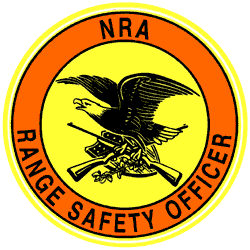 NRA Range Safety Officer
NRA Range Safety Officer
This course is nine hours long and is conducted in a classroom and may include a Range facility. NRA Range Safety Officer candidates will learn roles and responsibilities of an RSO; Range Standard Operating Procedures (SOPs); range inspection; range rules; range briefings; emergency procedures; and firearm stoppages and malfunctions. Each Range Safety Officer Candidate will receive an RSO Student Study Guide, a Basic Firearm Training Program brochure, an NRA Gun Safety Rules brochure, an Instructor Application/Course Evaluation form.
NRA Basic Metallic Cartridge Reloading Course
Teaches beginning reloaders the basic knowledge, skills, and attitude necessary to safely reload metallic cartridges. This course is eight hours in length and is conducted in a classroom. Each student is taught reloading safety; centerfire cartridge components; using the reloading manual and reloading data; equipment; and the metallic cartridge reloading process. Students will receive the NRA Guide to Reloading handbook, the Basic Reloading Student Exam, a course completion certificate, NRA Gun Safety Rules brochure, a Basic Firearm Training Program brochure, an Instructor Application/Course Evaluation form.
NRA Basic Shotgun Shell Reloading Course
Teaches beginning reloaders the basic knowledge, skills, and attitude necessary to safely reload shotgun shells. This course is six hours in length and is conducted in a classroom. Each student is taught reloading safety; shotgun shell components; using the reloading manual and reloading data; equipment; and the shotgun shell reloading process. Students will receive the NRA Guide to Reloading handbook, the Basic Reloading Student Exam, a course completion certificate, NRA Gun Safety Rules brochure, a Basic Firearm Training Program brochure, an Instructor Application Course/Evaluation form.
NRA Eddie Eagle GunSafe Program
What is The Eddie Eagle GunSafe® Program?
The Eddie Eagle GunSafe® Program teaches children in pre-K through third grade four important steps to take if they find a gun. These steps are presented by the program's mascot, Eddie Eagle, in an easy-to-remember format consisting of the following simple rules:
STOP!
Don't Touch.
Leave the Area.
Tell an Adult.
Begun in 1988, The Eddie Eagle GunSafe® Program has reached more than 26 million children - in all 50 states. This program was developed through the combined efforts of such qualified professionals as clinical psychologists, reading specialists, teachers, curriculum specialists, urban housing safety officials, and law enforcement personnel.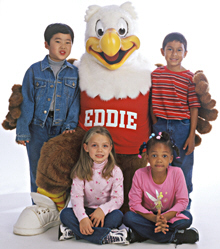 Anyone may teach The Eddie Eagle GunSafe® Program, and NRA membership is not required. The program may be readily incorporated into existing school curriculum, taught in a one- to five-day format, and used to reach both levels or simply one or two grades. Materials available through this program are: student workbooks, 7-minute animated DVD, instructor guides, brochures, and student reward stickers. Program materials are also available in Spanish.
Anyone may teach The Eddie Eagle GunSafe® Program, and NRA membership is not required. The program may be readily incorporated into existing school curriculum, taught in a one- to five-day format, and used to reach both levels or simply one or two grades. Materials available through this program are: student workbooks, 7-minute animated DVD, instructor guides, brochures, and student reward stickers. Program materials are also available in Spanish.
The NRA is committed to helping keep America's young children safe. In efforts to do so, we offer our program at a nominal fee. Schools, law enforcement agencies, hospitals, daycare centers, and libraries may be eligible to receive grant funding to defray program costs. Grant funding is available in many states to these groups to cover the cost of all program curriculum materials.
The purpose of the Eddie Eagle Program isn't to teach whether guns are good or bad, but rather to promote the protection and safety of children. The program makes no value judgments about firearms, and no firearms are ever used in the program. Like swimming pools, electrical outlets, matchbooks and household poison, they're treated simply as a fact of everyday life. With firearms found in about half of all American households, it's a stance that makes sense.
Eddie Eagle is never shown touching a firearm, and he does not promote firearm ownership or use. The program prohibits the use of Eddie Eagle mascots anywhere that guns are present. The Eddie Eagle Program has no agenda other than accident prevention - ensuring that children stay safe should they encounter a gun. The program never mentions the NRA. Nor does it encourage children to buy guns or to become NRA members. The NRA does not receive any appropriations from Congress, nor is it a trade organization. It is not affiliated with any firearm or ammunition manufacturers or with any businesses that deal in guns and ammunition.
For more information on the Eddie Eagle GunSafe® Program please see https://eddieeagle.nra.org/
